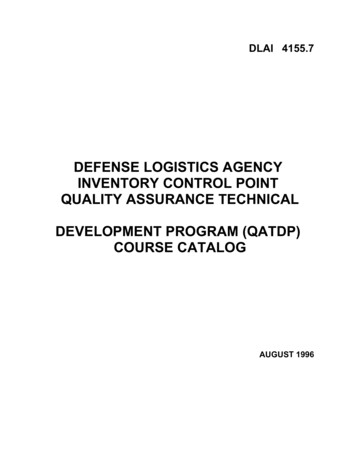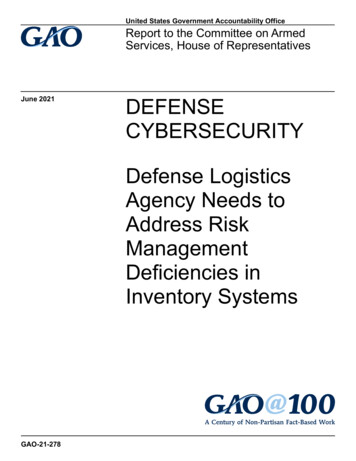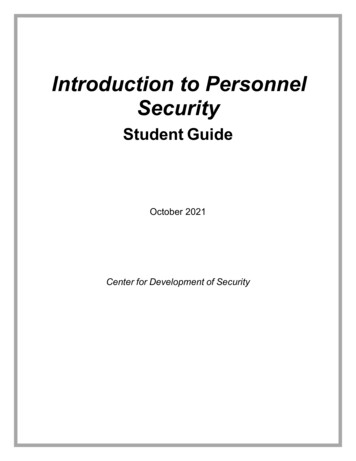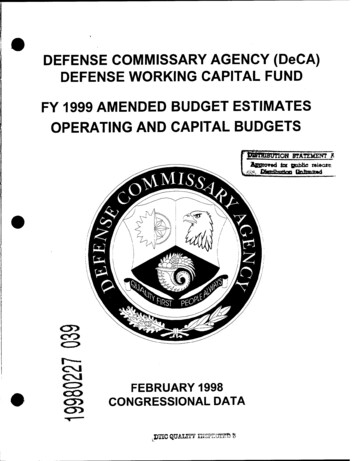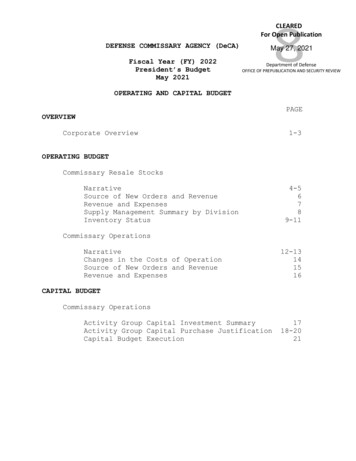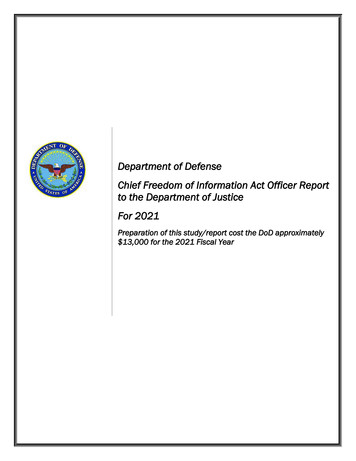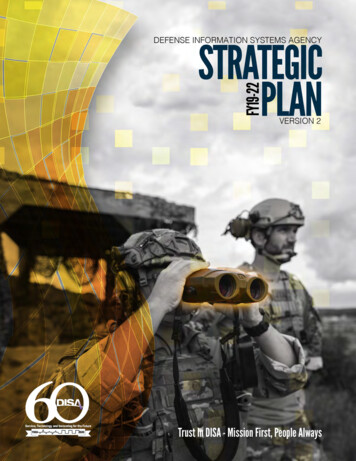
Transcription
A LETTERFROM THEDIRECTORIn less than a year, our mission environment, communitiesand lives have dramatically changed as a result of thenovel coronavirus disease 2019. We faced manyunforeseen challenges and together, we have metevery one of them with quick and decisive action. I amincredibly proud of how our workforce responded to theseextraordinary circumstances. The Department of Defenseand all of its components depended on DISA to delivercapabilities for the unprecedented large-scale maximumtelework that enabled us all to continue our respectivemissions in support of the warfighter.For years, we have been moving toward a more mobilecapable workforce where data are accessible anywhere:while on deployment, during TDY and while teleworking.No matter the obstacle, we have found ways to meet themission and consistently delivered on our commitment tothe department and each of our mission partners.Through teamwork and dedication, we have supported thewarfighter and the administration’s whole-of-governmentresponse, directly impacting frontline workers andwarfighters who defend our nation. Key examples includethe rapid installation of new circuits for hospital ships andfield hospitals across the country, and circuit upgradesthat increased bandwidth for military departments to meetemerging needs. With the vast majority of DoD personnelteleworking for their protection, we have enabled remotecapabilities by accelerating the DoD Mobility ClassifiedCapability, increasing Non-classified Internet ProtocolRouter Network circuit capacity and Commercial VirtualRemote capabilities, and accelerating contract awards likethe Antivirus Home Use Program. DISA enabled missioncritical access to classified capabilities by expanding theability to support secure remote access and provisioning arange of devices to support users globally. DISA increasedcapacity for enterprise services such as DefenseCollaboration Service, Global Video Service, Outlook WebAccess and Enterprise Audio Conferencing bridges inorder to support teleworking by five to 10 times growth ormore.DISA Director and Commander, Joint Force Headquarters-Department of Defense Information Network, NavyVice Adm. Nancy A. Norton addresses the workforce at the February 2020 DISA/JFHQ-DODIN Town Hall. Photocredit: T.L. Burton, DISA.2DISA FISCAL YEARS 2019-2022 STRATEGIC PLAN VERSION 2This year is especially significant because we arecelebrating our 60th anniversary. From the time it wasestablished as the Defense Communications Agencyon May 12, 1960, DISA has continued to leverage newservices, technology and innovation to confront newchallenges. We have served around the world insupport of our joint warfighters across every domain,and through multiple conflicts.Our updated DISA Strategic Plan highlights the waysthat we will endeavor to be the trusted provider toconnect and protect the warfighter in cyberspace.This year amplified DISA’s commitment to supportjoint warfighters, national-level leaders and missionand coalition partners, despite the challengespresented by the COVID-19 pandemic.This crisis helped affirm that we live our ethos – Trustin DISA: Mission First, People Always. Our greatestassets are our people. Our incredibly dedicated,agile and resilient workforce has not only survived butthrived while accomplishing our no-fail mission.While there are still challenges ahead, DISA’s work toenable the department’s mission continues, and ourresults demonstrate our resolve.Nancy A. NortonVice AdmiralUnited States NavyDirector, DISACommander, JFHQ-DODINDISA FISCAL YEARS 2019-2022 STRATEGIC PLAN VERSION 23
INTRODUCTIONTABLE OFCONTENTSA Letter from the Director.3Table of Contents. 4Introduction. 5Strategic Framework. 61.0 OPERATE AND DEFEND.91.1 Modernize the Infrastructure.101.2 End User Support.121.3 Computing. 131.4 Defensive Cyber Operations –Internal Defensive Measures.141.5 Readiness.142.0 ADOPT BEFORE WE BUY,AND BUY BEFORE WE CREATE. 172.1 Optimize for the Enterprise.182.2 Strengthen Cybersecurity.192.3 Drive Innovation. 22Technology Roadmap.283.0 ENABLE PEOPLE AND REFORM THE AGENCY. 313.1 Enable People. 333.2 Reform the Agency. 38Conclusion.424ETHOS: TRUST IN DISA -MISSION FIRST, PEOPLE ALWAYSMISSIONTo conduct Department of Defense InformationNetwork operations for the joint warfighter toenable lethality across all warfighting domainsin defense of our nation. DISA plans,engineers, acquires, tests, fields, operates,and assures information-sharing capabilities,command and control solutions and a globalenterprise infrastructure to support DoD andnational-level leadership.VISIONTo be the trusted provider toconnect and protect the warfighterin cyberspace.CREEDWe are a combat support agency.We unite diversity ofTalent throughRespect,Unity,Service, andTeamwork, leadinginnovation and success for thewarfighter in defense of our nation.VALUESDuty thatInspiresService andAccountability.DISA FISCAL YEARS 2019-2022 STRATEGIC PLAN VERSION 2This DISA Strategic Plan fiscal years 2019-2022,Version 2, is a refresh of Version 1 of the plan; whichwas released in 2019. This refresh incorporatesupdates to our priorities in light of a changedstrategic environment characterized by rapidlyshifting global and cyberspace landscapes. In thisera of technological advancement in the cyberdomain, DISA is continually seeking new waysto meet the needs of the end user that demandsresponsive, resilient, secure and high-quality ITservices. We have learned from the lessons ofthis past year combatting our invisible adversary,COVID-19, to sharpen our attention on criticalinitiatives to deliver capabilities to our missionpartners, and to care for and cultivate our workforce.At the same time, DISA’s mission has grownover the past few years, and we are focused onbuilding capability to move into the future. Thefuture incorporates new technologies such asfifth generation (5G) mobile networks and cloudcomputing. DISA recognizes that we must acceleratetechnology modernization to continue to meetour joint warfighters’ ever-increasing informationexchange needs.industrial base will gain a clear understanding of ourpriorities, and spark new ideas of ways tocollaborate with us to jointly fill capability gaps.The strategic plan is an overarching frameworkthat informs planning priorities, resource allocationand assessment criteria. It provides a framework toexplore technologies that will contribute to a moresecure, seamless and cost-effective architecturefor DoD. DISA’s strategic plan continues to align tonational and defense-level strategies, namely TheNational Security Strategy, National Cyber Strategy,National Defense Strategy, DoD Cyber Strategy andDoD Digital Modernization Strategy. The DoD’s longterm cyber-strategic approach is based on mutuallyreinforcing lines of effort to build a more lethal jointforce, compete and deter in cyberspace, expandalliances and partnerships, reform the departmentand cultivate talent. Collectively, these strategiesguided the development of the strategic plan andsupport DoD’s goal to strengthen the security andresilience of networks and systems that contribute tocurrent and future U.S. military advantages.Who is this plan for, and how isit intended to be used?This document serves multiple purposes as areference for internal and external audiences. Thisstrategy helps our workforce align activities, setfuture goals and see the utility and value of ourcontribution to an overarching DoD informationtechnology mission. We hope that mission partnerswill see the breadth and diversity of our servicesand determine new ways to better leverage DISAas the nation’s premier IT combat support agency.Additionally, we hope that members of the defenseDISA FISCAL YEARS 2019-2022 STRATEGIC PLAN VERSION 25
1STRATEGICFRAMEWORK213232.3 Drive InnovationThis strategic framework shows how the goals, objectives andcapabilities support the agency’s mission of conducting DoDINoperations to enable lethality across all warfighting domains indefense of our nation. These are the three goals that supportour enduring mission: Operate and Defend, Adopt Before We Buyand Buy Before We Create, and Enable People and Reform theAgency. The 10 supporting objectives are the actions takento achieve the goals, and the 31 capabilities are the programs,projects and initiatives that support the objectives.1.0 OPERATE AND DEFEND1.1 Modernize the Infrastructure1.1.1 Network Enhancements1.1.2 Internet Protocol v61.1.3 Network Operations1.1.4 Spectrum1.2 End User Support1.2.1 Fourth Estate Network Optimization1.2.2 Pentagon and National Capital Region Support1.2.3 National Leadership Command Capability2.3.1 Automation2.3.2 Development, Security, Operations/Agile Software Development2.3.3 Industry Engagements2.3.4 Innovative Acquisition2.3.5 Assured Identity2.3.6 Mobile/Desktop Convergence2.3.7 Universal Gateway3.0 ENABLE PEOPLE AND REFORM THE AGENCY3.1 Enable People3.1.1 Trust and Accountability Framework3.1.2 Recruiting/Hiring3.1.3 Retention3.1.4 Training3.1.5 Cyber Excepted Service3.2 Reform the Agency3.2.1 Business Process System Modernization3.2.2 Data Management3.2.3 Customer Service1.3 Computing1.3.1 Computing Ecosystem1.3.2 On Premise Cloud1.4 Defensive Cyber Operations – Internal Defensive Measures1.5 Readiness2.0 ADOPT BEFORE WE BUY AND BUY BEFORE WE CREATE2.1 Optimize for the Enterprise2.1.1 Cloud2.1.2 Defense Enterprise Office Solution2.1.3 Mobility Offering2.1.4 Testing2.2 Strengthen Cybersecurity2.2.1 Boundary Defense2.2.2 Regional Defense2.2.3 Endpoint Security6DISA FISCAL YEARS 2019-2022 STRATEGIC PLAN VERSION 2DISA FISCAL YEARS 2019-2022 STRATEGIC PLAN VERSION 27
123123OPERATEANDDEFEND8DISA FISCAL YEARS 2019-2022 STRATEGIC PLAN VERSION 2DISA FISCAL YEARS 2019-2022 STRATEGIC PLAN VERSION 29
OPERATEandDEFEND121.0 OPERATE AND DEFENDIn today’s landscape of increasing cyberthreats, the ability to deliver services andcapabilities across all domains – land, air, sea, space and cyberspace – allows missionpartners to maintain global leadership and to deny unwanted advantages to adversaries.DISA understands these requirements, and our desired end state is to deliver secure,available and reliable services and capabilities to mission partners in a contested andrapidly changing cyberspace environment. Our support to crisis and combat operationstakes on many forms, such as employing tool suites to provide real-time, robust monitoringof an infrastructure to lessen interrupted service, or developing interagency andinternational partnerships to strengthen protection of critical assets. We are focused onmaximizing information sharing to enable a threat-based approach to defensive cyberspaceoperations, and continually improving our readiness to support DoD campaigns. DISA ison the leading edge of deploying, operating and sustaining cyber tools, capabilities andexpertise to maximize DoDIN operations that support multi-domain operations and enhancelethality.1.1 Modernize the InfrastructureConsistent with the 2018 National Defense Strategy’s charge to reform thedepartment, DISA modernizes the infrastructure to improve the security, resiliencyand capacity for DoD networks. One focus of our modernization initiatives is tostandardize configurations for greater performance and affordability. Another focusis to consolidate and converge data centers, networks, service desks and networkoperation centers into a secure, integrated and improved environment. A moderninfrastructure reduces the cost and complexity to operate while improving customerservice with transparency. Over the fiscal years 2020-2021, DISA is focused onachieving objectives under the following major lines of effort:1.1.1 Network EnhancementsNetwork enhancements support an everything-over-internet protocolarchitecture to eliminate obsolete technology, optimize network efficienciesand service delivery and provide multi-path survivable infrastructure. DISA ispursuing related Defense Information Systems Network evolution initiativesin networking, collaborations, satellite communications, mobility, enterpriseoperations and network management, and cybersecurity capabilities. Within10DISA FISCAL YEARS 2019-2022 STRATEGIC PLAN VERSION 21323these capabilities there are common goals to enhance the infrastructureof network elements to better the overall DISN functional architecture. Weare evolving toward the next generation DISN Infrastructure to deliver highbandwidth, agile, survivable and secure networking capabilities.A main focus of our enhancement initiatives is to consolidate infrastructureby developing common architectures and sharing resources. In ourongoing work to modernize the SATCOM gateway, for example, we areconverging disparate management tools into one platform that will providea continuous, accurate and real-time SATCOM situational awareness to theuser communities.1.1.2 Internet Protocol v6The goal of this initiative is to employ a global converged networkinfrastructure by converting to an IP-based architecture and implementInternet Protocol version 6, where fault isolation and dynamic routingof network traffic enable enhanced service delivery and prevent serviceinterruption to the end user. A global converged network infrastructureimproves interoperability, security, resilience and compliance with DoDnet-centric directives and lowers sustainment costs while enhancingresponsiveness to new requirements. DISA is working to enable DISN corehardware by 2021 and to enable all DISA catalogue services and externalIT systems by 2025.1.1.3 Network OperationsDISA enhances operations to ensure mission partners have secure,available and reliable services and capabilities to achieve their mission ina contested cyberspace environment. DISA enhances operations throughthe operation and defense of the DISA-managed portion of the DoDIN,management of the Cyber Security Service Provider program, directsupport to combatant commands and support of Joint Force HeadquartersDepartment of Defense Information Network and United States CyberCommand in their missions to achieve cyberspace superiority. Our aim isto improve reliability and availability of delivered services by conductingmission assurance and critical infrastructure protection assessmentsfocused on reducing or eliminating infrastructure potential points of failure.1.1.4 SpectrumDISA is transforming DoD joint electromagnetic spectrum operations toimprove holistic spectrum situational awareness through improved datacapture models, processes and capabilities. This improves lethality andsurvivability for spectrum-dependent systems supporting the wirelessportion of the DoDIN. We are developing technical frameworks that enableDISA FISCAL YEARS 2019-2022 STRATEGIC PLAN VERSION 211
OPERATEandDEFEND121323promising new electromagnetic spectrum access technologies to improvefull-range spectrum access for the warfighter. During this strategic timeframe, we are developing initial system requirements and architecture forElectromagnetic Battle Management capabilities, and supporting DoD andnational spectrum sharing and reallocation initiatives.1.2 End User SupportAs DoD pursues the National Defense Strategy, the agency has a number of initiativesin support of reform and enhanced security. These include end user or desktopsupport for most elements within the Pentagon and its geographically distributedorganizations, as well as most organizations within the Fourth Estate. The FourthEstate is comprised of DoD agencies and field activities that are not part of the militarybranches. These organizations include the Office of the Secretary of Defense, theJoint Staff, DoD field activities, the combatant commands, and defense agencies.1.2.1 Fourth Estate Network OptimizationThe purpose of this program is to modernize DoD’s IT architecture,consolidate networks, reduce costs, improve business practices and mitigateoperational and cyber risks. DISA’s objectives are to manage all applications,tools, processes and the contracts necessary to support the Fourth Estateorganizations and their day-to-day common IT functions. We are activelydelivering consolidated enterprise services, end-user devices, desktopsupport and local and wide area network connectivity. We are onboarding14 organizations between fiscal years 2020-2025 onto DoDNet, and 800 ITgovernment personnel will join DISA over a period of six years.1.2.2 Pentagon and National Capital Region SupportDISA’s Joint Service Provider provides a full range of DoD IT services tothe Pentagon and National Capital Region to meet mission and businessrequirements. DISA JSP’s work is prioritized under three strategic areas:1) Optimize the Customer Experience, 2) Operate, Defend and Hardenthe Network, and 3) Enable People and Improve Processes. Under its firstpriority, DISA JSP is focused on enabling maximum mission effectivenessfor the customer through a Gold Standard level of service, and betteraligning DISA and Fourth Estate Network Optimization service offerings for12DISA FISCAL YEARS 2019-2022 STRATEGIC PLAN VERSION 2DISA personnel staff the agency’s Joint Operations Command Center. Image design July 2014: Crystal Kim, DISA.increased transparency. Under its second priority, DISA JSP is focused onmodernizing the enterprise network and improving cybersecurity. Finally,DISA JSP is working to automate pipelines, tools and standards neededto support rapid development. This includes moving to a Defense WorkingCapital Fund compliant financial model by fiscal year 2022 to establishconsistent service taxonomy and standardize delivery to customers.1.2.3 National Leadership Command CapabilityDISA is proud to support the National Leadership Command Capabilityframework. Our work supports three key areas: Presidential and seniorleader communications, continuity of operations and governmentcommunications, and Nuclear Command, Control and Communications.Our goals are to modernize and sustain senior leader communications, aswell as ensure they are enabled with the latest cybersecurity protection.DISA will continue to provide centralized management and configurationcontrol of select NLCC command and control capabilities as directed by theDoD Chief Information Office and Council on Oversight of NLCC Systems.1.3 ComputingThe agency continues to support computing requirements with its data centersnow called Computing Ecosystems. The ecosystem has expanded its number ofcomputing sites under the direction of DoD CIO to take ownership of key servicemanaged computing centers. The intent is to modernize them to enterprisestandards.DISA FISCAL YEARS 2019-2022 STRATEGIC PLAN VERSION 213
OPERATEandDEFEND121.3.1 Computing EcosystemDISA continues to implement and optimize the computing ecosystem tostreamline command and control of mission-critical applications and toimprove information-sharing capabilities. During this strategic time frame,we will host critical traditional systems, divest outdated legacy computingsystems, and where appropriate, shift to cloud-based alternatives. We areactively onboarding new mission-critical applications and working towardan infrastructure technical refresh for NIPRnet and SIPRnet in 2021.3123trust among mission partners. We are actively incorporating lessons learned fromdirectly supporting named military operations and globally integrated exercises intothe integrated planning and exercise lifecycle. This information feeds our annualcontingency planning documents, including combatant command campaign plans,global campaign plans and DoD top-priority contingency plans.Facilities and infrastructure management is strategically important to supportingagency mission readiness. Properly maintained and operated facilities supportthe nation’s critical infrastructure requirements and address the evolving needsof the workforce. Therefore, DISA continuously assesses the need for facilityimprovements and capital investments, and we are actively engaged in the militaryconstruction planning and programming process to fulfill requirements in fiscalyears 2021-2022 and beyond.1.3.2 On Premise CloudFor those unclassified systems requiring on-premise cloud solutions,milCloud 2.0 over the Sensitive but Unclassified Internet Protocol DataNetwork is deployed and expanding. For cloud-ready systems classified atthe secret level, milCloud 2.0 is currently being deployed.1.4 Defensive Cyber Operations –Internal Defensive MeasuresWe are expanding resiliency through the implementation of Defensive CyberOperations-Internal Defensive Measures for rapid identification of newvulnerabilities. The purpose of our efforts is to eliminate known vulnerabilitiesand field new capabilities for defense-in-depth and incident response analysis.Enhancements must target the complete spectrum of technologies from end-pointto internet and every tier in between. DCO-IDM missions are conducted at globaland enterprise levels and within DISA-operated portions of the DoDIN to preserveits confidentiality, availability and integrity. During this strategic time frame, weare continuing to implement effective controls as measured through DoD’s CIOCyber Hygiene Scorecard, and to extend Cyber Security Service Provider serviceofferings to higher security classification levels.1.5 ReadinessDISA is focused on strengthening readiness by expanding exercise planning andparticipation to build proficiency, improve interoperability and establish mutual14DISA FISCAL YEARS 2019-2022 STRATEGIC PLAN VERSION 2Assistant to the Director, Army Maj. Gen. Garrett S. Yee addresses attendees at DISA’s November 2019 Forecast toIndustry conference, while they wear 3D glasses to uncover messages hidden in conference signage.Photo credit: T.L. Burton, DISA.DISA FISCAL YEARS 2019-2022 STRATEGIC PLAN VERSION 215
121323ADOPTBEFORE WEBUY AND BUYBEFORE WECREATE16DISA FISCAL YEARS 2019-2022 STRATEGIC PLAN VERSION 2DISA FISCAL YEARS 2019-2022 STRATEGIC PLAN VERSION 217
ADOPTBEFORE WE BUYand BUY BEFOREWE CREATE122.0 ADOPT BEFORE WE BUY ANDBUY BEFORE WE CREATEThe Adopt Before We Buy and Buy Before We Create process improves the speed ofdelivery of services and capabilities for DoD. When a mission partner requests a solution,the agency uses this process to determine the best way to meet the requirement. First,the agency determines if the solution already exists within DoD and if it is scalable tomeet the mission requirement. Second, if the solution is not available or scalable, theagency buys it from industry partners. If the solution is not available from DoD or industrypartners, the third and least agile method to fulfill the requirement is by creating a customsolution. When this is required, the agency provides short-term solutions to fill thecapability gap, while the long-term solution is developed and implemented. This processstrengthens mission partner collaboration by developing and delivering a customizedservice or capability solution based on the specific requirements.2.1 Optimize for the Enterprise2.1.1 CloudOur vision is to establish DISA as the thought and product deliveryleader for cloud integration and sustainment. We are seeking to developa cloud-advisory framework to outline operational benefits, costs andpotential drawbacks for approved DoD commercial-cloud offerings.This process requires proactive engagement with mission and industrypartners to evolve department cloud-based offerings to meet changingmission requirements. DISA is leveraging the benefits of cloud across allservices and capabilities by investing in commercial cloud capabilities andsupporting DoD’s cloud initiative to modernize the IT enterprise.Working in accordance with DoD cloud-adoption goals, our objective is tobuild enterprise identity and authentication for DoD cloud environments.The team is enabling commercial-cloud access to prepare for integration ofJoint Enterprise Defense Infrastructure specific common services, as wellas outside the continental United States and tactical cloud access. DISAis deploying a third generation cloud access point construct and evolvinginternet connectivity to approved Impact Level 4/5 commercial cloudofferings.18DISA FISCAL YEARS 2019-2022 STRATEGIC PLAN VERSION 21323Another important cloud initiative is the implementation of a Voice CloudAccess Point solution. This positions DISA to be the provider of choice forcloud voice over internet protocol connections to the DoD Impact Level 5cloud tenants. The VCAP solution optimizes routing of voice traffic whileproviding a secure DoDIN anchor point for all mission partner IL5 cloudhosted solutions. DISA has implemented initial capability, and will expandto additional sites in fiscal year 2021 to get to full operational capability.2.1.2 Defense Enterprise Office SolutionDefense Enterprise Office Solution is an enterprise commercial-cloudservice offering that supports DoD’s enterprise collaboration andproductivity services strategy to replace existing DoD capabilities. Theprogram acquires and implements common enterprise applications andservices for joint use across DoD, standardizing cloud adoption andenabling cross-department collaboration. DEOS will be deployed andimplemented using a multifaceted approach for NIPRNet and SIPRNetenvironments. In this strategic time frame, we will facilitate migration fromlegacy enterprise services to DEOS, and sunset legacy services. Thisincludes standing up, testing and authorizing NIPRNet services within thecontinental United States, as well as initiating OCONUS and SIPRNetservices.2.1.3 Mobility OfferingCOVID-19 and maximum telework has accelerated DISA’s goal to makedata accessible to every owner from anywhere at any time. DoD mobilityoffers services that ensure interoperability, increased security, and reliableaccess to information for our mobile workforce. Strategic focus areas aremobile device policy and standards, development of mobile web and apps,and enterprise mobility for unclassified and classified use. DoD mobilitycapabilities are being pursued at the unclassified, secret and top-secretlevels to enable government-owned mobile devices access to authorizedinformation services.2.1.4 TestingDISA’s goal is to use Joint Interoperability Test Command for all operationaltests, evaluations and assessments to rigorously test all services andcapabilities before implementation. This reduces duplicative testing effortsand overall programmatic costs to realize cost savings to our missionpartners. We are also finding new ways to gain efficiencies in the testingenterprise. For example, we are currently pursuing the concept of anEnterprise Integration and Assessments Environment to replace theDistributed Development Test Enterprise with a more operationally relevanttest environment. This effort increases automation and data managementDISA FISCAL YEARS 2019-2022 STRATEGIC PLAN VERSION 219
ADOPTBEFORE WE BUYand BUY BEFOREWE CREATE12within a centralized framework. We anticipate that this will improve test andevaluation capabilities to help accelerate the pace of modernization activitiesundertaken by Distributed Common Ground/Surface Systems Programs ofRecord.2.2 Strengthen CybersecurityThe current cyber domain is a dynamic, complex and contested battlespace constantlyunder attack by an ever-evolving array of highly competent adversaries. Thesemalicious actors seek to leverage the characteristics of the cyber domain to theiradvantage and compromise our ability to operate effectively in cyberspace. In orderto defend against these evolving threats, we are pursuing actions across domainsand transport layers that will enhance, standardize and centralize the defense ofour cybersecurity environment. We want to enhance the defensive architecture witha focus on defending against both external and internal attacks, detecting lateralmovement and fully incorporating more robust endpoint capabilities in a synchronizedand standardized defensive implementation.One of the ways we are pursuing a robust defensive architecture is through our “zerotrust” architecture program that acts as an enabling attribute to tie together all securitysolution sets. DISA is working in partnership with the National Security Agency, U.S.Cyber Command, and DoD CIO to develop a dynamic zero trust lab environment ableto replicate existing and near-state technologies to test zero trust capabilities.There are currently three layers of defense in the DISN architecture that fall intoDISA’s Defensive Cyberspace Operations capabilities: boundary defense, regionaldefense and endpoint security.2.2.1 Boundary DefenseThe boundary defense layers include internet access points at the edgeof the unclassified DoDIN. DISA conducts the majority of its DCO from theboundaries with multiple defensive capabilities. In this strategic time frame, weare working on several programs in support of boundary defense, to include: Threat Intel – This refers to using more actionable threat intelligence toblock malicious behavior. This comes from internally sharing information20DISA FISCAL YEARS 2019-2022 STRATEGIC PLAN VERSION 21323with devices at the Internet Access Provider level, or gaining additionalthreat information from vendors. Our projected end state is in fiscalyear 2022. Cloud Based Internet Isolation – This is a tool that allows ourmachines to remotely browse internet traffic whil
established as the Defense Communications Agency on May 12, 1960, DISA has continued to leverage new services, technology and innovation to confront new . challenges. We have served around the world in . support of our joint warfighters across every domain, and through multiple conflicts. Our updated DISA Strategic Plan highlights the ways
